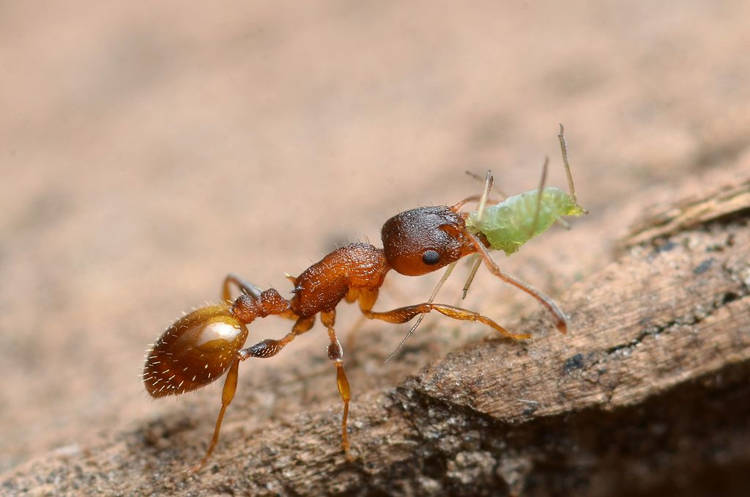Scientists have discovered that Temnothorax ants infected by a certain tapeworm parasite can live at least three times longer than their uninfected peers while maintaining a youthful appearance and getting special treatment.
A multi-year scientific study published in May of this year has revealed a phenomenon worthy of a science-fiction or fantasy blockbuster – a parasitic tapeworm that grants its host eternal youth while making them irresistible to their uninfected peers, who work harder just to bring them food and fulfill their every wish. It sounds unreal, but scientists at the Johannes Gutenberg University in Mainz, Austria have studied colonies of Temnothorax ants and found that when they are infected with the tapeworm Anomotaenia brevis, they become virtually immortal.
Temnothorax-nylanderi is a relatively common species of small ants that live in forests throughout Central Europe. They form small colonies on the forest floor, inside acorns or wooden branches, and most importantly, they serve as an intermediate host for the tapeworm Anomotaenia brevis. Up to 70 parasitic larvae can survive in the hemolymph, the body fluid of insects, but instead of competing for resources with their hosts and slowly killing them, the parasites appear to extend their lives considerably, possibly even indefinitely.

Photo: Gilles San Martin/Wikimedia Commons
Typically, Temnothorax worker ants have a short life span and die within a few months of hatching from the eggs, so scientists had long been intrigued by observed specimens that not only survived for several years, but also retained a youthful, almost juvenile appearance, and seemed to enjoy special privileges in the colony.
For this study, Professor Susanne Foitzik and her team tracked 58 colonies of Temnothorax ants in the lab for three years, paying close attention to those specimens infected with the Anomotaenia brevis tapeworm. 53% of these worker ants were alive at the end of the study, while all of the uninfected specimens from the same generation were long dead. Only the queens, which can live for up to 20 years, were still alive.
“We tracked the survival rate of the workers and queens in both infected and uninfected ant colonies over three years, until more than 95 percent of the uninfected workers had died,” Professor Foitzik said. “It is quite extraordinary that a parasite can trigger such a positive change in its host. This lifespan extension is very unusual.”
How exactly the tapeworm larvae trigger this “fountain of youth effect” is unclear, but the limited evidence suggests that they might be altering the expression of ant genes that affect aging, while also releasing proteins containing antioxidants into the ants’ hemolymph. One thing is for sure, though, the ants not only live longer, but they look more youthful than uninfected specimens as well.
Normally, young Temnothorax workers will be yellow, while older ants will turn brown. Their skin will thicken and harden, but Temnothorax ants infected with tapeworms still have soft skin and retain their yellow appearance. It’s not clear by how long the larvae can prolong the lives of their hosts, but three lifecycles of uninfected specimens was the lowest duration recorded during the study. Theoretically, these infected ants could surpass the 20-year life expectancy of queens.
Another potential cause of the increased life expectancy of infected worker ants is the treatment they enjoy within their colonies. The larvae somehow make them more “popular” than the queens, which hasn’t been observed in ant societies before. Infected ants are slightly better-taken care of by workers than the queens. Uninfected workers will spend time grooming the infected ants and work harder to shower them with food.
“The infected insects get more attention and are fed, cleaned, and looked after better. They even benefit from slightly more care than the nest’s queen,” Professor Susanne Foitzik explained.
But it is in this special treatment that the parasite’s deception lies. Because its “fountain of eternal” youth is not a blessing, but a curse in disguise. Enjoying all the perks of a queen makes infected Temnothorax ants lazy. Without the need to work for food and attention, they just spend their days roaming around the colony without a goal, and this makes them easier targets.
To complete their complex lifecycles, Anomotaenia brevis tapeworms need to be ingested by birds, and they can survive for years in the ants’ hemolymph until that happens. If or when a woodpecker discovers the colony, the uninfected ants will scramble to grab their larvae and run away, while the lazy “immortals” won’t even bother to escape.
One day, during the three-year study, Professor Foitzik unexpectedly opened up the entire roof of the lab-grown ant nest just to see how they would react, and not that “while the other worker ants quickly grabbed the larvae and ran, the Temnothorax infected with the tapeworm simply looked up at the sky as if wondering, ‘Oh what happened?'”
So it turns out that the tapeworm larvae are just grooming their hosts for their ultimate purpose – to get eaten by birds, so the parasite can complete its life-cycle. It will reproduce inside its main aviary host, and spawn new larvae that spread through bird droppings and infect new ants.
While getting set up to be eaten by a predator sounds like a bad outcome, getting to live several lifetimes, retaining your youth, and becoming irresistible to your peers sounds like a good tradeoff. I know we’ve featured much worse ways of dying after being infected by parasites, like being turned into a zombie bodyguard, or being used as a mindless drone, or being eaten from inside and forced to dig your own grave.






